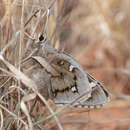Conservation Status
provided by University of Alberta Museums
The only known Canadian population occurs in a yucca colony on and above the south-facing slopes of the Milk River, south of Onefour
- license
- cc-by-nc
- copyright
- University of Alberta Museums
Cyclicity
provided by University of Alberta Museums
Adults fly in late June in Alberta (eggs collected July 1). Late June – early July in Colorado and North Dakota (Scott, 1992)
- license
- cc-by-nc
- copyright
- University of Alberta Museums
Distribution
provided by University of Alberta Museums
Southern Texas, New Mexico and Arizona, north in the Great Plains to North Dakota and extreme south-eastern Alberta. In Canada and Alberta, known only from the Yucca colony on the north side of the Milk River valley south of Onefour, immediately north of the Montana border.
- license
- cc-by-nc
- copyright
- University of Alberta Museums
General Description
provided by University of Alberta Museums
A large (5.5 – 7.5 cm wingspan) heavy-bodied skipper. The dorsal wing surfaces are brownish black with white fringes and a series of pale marginal spots. Males are smaller and darker than females. Males have a series of six prominent white or pale tan spots on the outer costa and margin of the forewings, and a narrow yellow tan marginal band on the hindwings. Females have larger paler forewing spots which usually form a continuous band, and usually one or more pale spots on the hingwing in addition to the pale marginal band. In both sexes the ventral surfaces of the forewings are similar to the dorsal surfaces, but the hindwings are heavily dusted or frosted with pale scales and have several small white spots. This large skipper is unlikely to be mistaken for any other Alberta lepidopteran.
- license
- cc-by-nc
- copyright
- University of Alberta Museums
Habitat
provided by University of Alberta Museums
Yucca colonies on arid grasslands and badlands
- license
- cc-by-nc
- copyright
- University of Alberta Museums
Life Cycle
provided by University of Alberta Museums
Single brooded. Adults lay eggs on the leaves of yucca plants, and the larvae burrow into the rootstock to feed. Adults frequently perch on the dry flower stems of the host plant. The larger females make a clicking sound in flight.
- license
- cc-by-nc
- copyright
- University of Alberta Museums
Trophic Strategy
provided by University of Alberta Museums
The larvae feed only in the rootstocks of yucca (in Alberta, Yucca glauca Nutt.).
- license
- cc-by-nc
- copyright
- University of Alberta Museums

